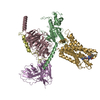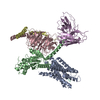+ Open data
Open data
- Basic information
Basic information
| Entry | Database: PDB / ID: 8zbe | ||||||
|---|---|---|---|---|---|---|---|
| Title | cryo-EM structure of the octreotide-bound SSTR5-Gi complex | ||||||
 Components Components |
| ||||||
 Keywords Keywords | MEMBRANE PROTEIN/IMMUNE SYSTEM / SSTR5 / octreoitde / structural protein / MEMBRANE PROTEIN-IMMUNE SYSTEM complex | ||||||
| Function / homology |  Function and homology information Function and homology informationsomatostatin receptor activity / G-protein activation / Activation of the phototransduction cascade / Glucagon-type ligand receptors / Thromboxane signalling through TP receptor / Sensory perception of sweet, bitter, and umami (glutamate) taste / G beta:gamma signalling through PI3Kgamma / G beta:gamma signalling through CDC42 / Cooperation of PDCL (PhLP1) and TRiC/CCT in G-protein beta folding / Activation of G protein gated Potassium channels ...somatostatin receptor activity / G-protein activation / Activation of the phototransduction cascade / Glucagon-type ligand receptors / Thromboxane signalling through TP receptor / Sensory perception of sweet, bitter, and umami (glutamate) taste / G beta:gamma signalling through PI3Kgamma / G beta:gamma signalling through CDC42 / Cooperation of PDCL (PhLP1) and TRiC/CCT in G-protein beta folding / Activation of G protein gated Potassium channels / Inhibition of voltage gated Ca2+ channels via Gbeta/gamma subunits / Ca2+ pathway / positive regulation of mini excitatory postsynaptic potential / G alpha (z) signalling events / beta2-adrenergic receptor activity / negative regulation of smooth muscle contraction / High laminar flow shear stress activates signaling by PIEZO1 and PECAM1:CDH5:KDR in endothelial cells / Glucagon-like Peptide-1 (GLP1) regulates insulin secretion / Vasopressin regulates renal water homeostasis via Aquaporins / neuropeptide binding / AMPA selective glutamate receptor signaling pathway / positive regulation of autophagosome maturation / norepinephrine-epinephrine-mediated vasodilation involved in regulation of systemic arterial blood pressure / Adrenaline,noradrenaline inhibits insulin secretion / heat generation / ADP signalling through P2Y purinoceptor 12 / norepinephrine binding / G alpha (q) signalling events / Adrenoceptors / G alpha (i) signalling events / positive regulation of lipophagy / Thrombin signalling through proteinase activated receptors (PARs) / negative regulation of multicellular organism growth / negative regulation of G protein-coupled receptor signaling pathway / cellular response to glucocorticoid stimulus / photoreceptor outer segment membrane / spectrin binding / response to psychosocial stress / endosome to lysosome transport / adrenergic receptor signaling pathway / diet induced thermogenesis / positive regulation of cytokinesis / alkylglycerophosphoethanolamine phosphodiesterase activity / positive regulation of cAMP/PKA signal transduction / adenylate cyclase binding / smooth muscle contraction / photoreceptor outer segment / G protein-coupled receptor signaling pathway, coupled to cyclic nucleotide second messenger / bone resorption / potassium channel regulator activity / positive regulation of bone mineralization / neuropeptide signaling pathway / neuronal dense core vesicle / brown fat cell differentiation / adenylate cyclase inhibitor activity / intercellular bridge / adenylate cyclase-activating adrenergic receptor signaling pathway / positive regulation of protein localization to cell cortex / regulation of sodium ion transport / T cell migration / Adenylate cyclase inhibitory pathway / D2 dopamine receptor binding / response to prostaglandin E / cardiac muscle cell apoptotic process / photoreceptor inner segment / adenylate cyclase regulator activity / G protein-coupled serotonin receptor binding / adenylate cyclase-inhibiting serotonin receptor signaling pathway / regulation of insulin secretion / cellular response to forskolin / receptor-mediated endocytosis / response to cold / Peptide ligand-binding receptors / regulation of mitotic spindle organization / Regulation of insulin secretion / clathrin-coated endocytic vesicle membrane / positive regulation of cholesterol biosynthetic process / negative regulation of insulin secretion / G protein-coupled receptor binding / response to peptide hormone / adenylate cyclase-inhibiting G protein-coupled receptor signaling pathway / adenylate cyclase-modulating G protein-coupled receptor signaling pathway / centriolar satellite / G-protein beta/gamma-subunit complex binding / cellular response to amyloid-beta / ADP signalling through P2Y purinoceptor 12 / mitotic spindle / Adrenaline,noradrenaline inhibits insulin secretion / GDP binding / G alpha (z) signalling events / ADORA2B mediated anti-inflammatory cytokines production / Cargo recognition for clathrin-mediated endocytosis / GPER1 signaling / glucose homeostasis / G-protein beta-subunit binding / heterotrimeric G-protein complex / sensory perception of taste / Clathrin-mediated endocytosis / positive regulation of cold-induced thermogenesis / amyloid-beta binding Similarity search - Function | ||||||
| Biological species |  Homo sapiens (human) Homo sapiens (human) Oplophorus gracilirostris (crustacean) Oplophorus gracilirostris (crustacean) synthetic construct (others) | ||||||
| Method | ELECTRON MICROSCOPY / single particle reconstruction / cryo EM / Resolution: 3.24 Å | ||||||
 Authors Authors | Li, Y.G. / Meng, X.Y. / Yang, X.R. / Ling, S.L. / Shi, P. / Tian, C.L. / Yang, F. | ||||||
| Funding support | 1items
| ||||||
 Citation Citation |  Journal: Acta Pharmacol Sin / Year: 2024 Journal: Acta Pharmacol Sin / Year: 2024Title: Structural insights into somatostatin receptor 5 bound with cyclic peptides. Authors: Ying-Ge Li / Xian-Yu Meng / Xiru Yang / Sheng-Long Ling / Pan Shi / Chang-Lin Tian / Fan Yang /  Abstract: Somatostatin receptor 5 (SSTR5) is highly expressed in ACTH-secreting pituitary adenomas and is an important drug target for the treatment of Cushing's disease. Two cyclic SST analog peptides ...Somatostatin receptor 5 (SSTR5) is highly expressed in ACTH-secreting pituitary adenomas and is an important drug target for the treatment of Cushing's disease. Two cyclic SST analog peptides (pasireotide and octreotide) both can activate SSTR5 and SSTR2. Pasireotide is preferential binding to SSTR5 than octreotide, while octreotide is biased to SSTR2 than SSTR5. The lack of selectivity of both pasireotide and octreotide causes side effects, such as hyperglycemia, gastrointestinal disturbance, and abnormal glucose homeostasis. However, little is known about the binding and selectivity mechanisms of pasireotide and octreotide with SSTR5, limiting the development of subtype-selective SST analog drugs specifically targeting SSTR5. Here, we report two cryo-electron microscopy (cryo-EM) structures of SSTR5-Gi complexes activated by pasireotide and octreoitde at resolutions of 3.09 Å and 3.24 Å, respectively. In combination with structural analysis and functional experiments, our results reveal the molecular mechanisms of ligand recognition and receptor activation. We also demonstrate that pasireotide preferentially binds to SSTR5 through the interactions between Tyr(Bzl)/Trp of pasireotide and SSTR5. Moreover, we find that the Q, N, F and ECL2 of SSTR2 play a crucial role in octreotide biased binding of SSTR2. Our results will provide structural insights and offer new opportunities for the drug discovery of better selective pharmaceuticals targeting specific SSTR subtypes. | ||||||
| History |
|
- Structure visualization
Structure visualization
| Structure viewer | Molecule:  Molmil Molmil Jmol/JSmol Jmol/JSmol |
|---|
- Downloads & links
Downloads & links
- Download
Download
| PDBx/mmCIF format |  8zbe.cif.gz 8zbe.cif.gz | 225.4 KB | Display |  PDBx/mmCIF format PDBx/mmCIF format |
|---|---|---|---|---|
| PDB format |  pdb8zbe.ent.gz pdb8zbe.ent.gz | 159.9 KB | Display |  PDB format PDB format |
| PDBx/mmJSON format |  8zbe.json.gz 8zbe.json.gz | Tree view |  PDBx/mmJSON format PDBx/mmJSON format | |
| Others |  Other downloads Other downloads |
-Validation report
| Summary document |  8zbe_validation.pdf.gz 8zbe_validation.pdf.gz | 406.3 KB | Display |  wwPDB validaton report wwPDB validaton report |
|---|---|---|---|---|
| Full document |  8zbe_full_validation.pdf.gz 8zbe_full_validation.pdf.gz | 418.9 KB | Display | |
| Data in XML |  8zbe_validation.xml.gz 8zbe_validation.xml.gz | 22.4 KB | Display | |
| Data in CIF |  8zbe_validation.cif.gz 8zbe_validation.cif.gz | 35.2 KB | Display | |
| Arichive directory |  https://data.pdbj.org/pub/pdb/validation_reports/zb/8zbe https://data.pdbj.org/pub/pdb/validation_reports/zb/8zbe ftp://data.pdbj.org/pub/pdb/validation_reports/zb/8zbe ftp://data.pdbj.org/pub/pdb/validation_reports/zb/8zbe | HTTPS FTP |
-Related structure data
| Related structure data |  39901MC  8zcjC M: map data used to model this data C: citing same article ( |
|---|---|
| Similar structure data | Similarity search - Function & homology  F&H Search F&H Search |
- Links
Links
- Assembly
Assembly
| Deposited unit | 
|
|---|---|
| 1 |
|
- Components
Components
-Guanine nucleotide-binding protein ... , 3 types, 3 molecules BDC
| #2: Protein | Mass: 40445.059 Da / Num. of mol.: 1 Source method: isolated from a genetically manipulated source Source: (gene. exp.)  Homo sapiens (human) / Gene: GNAI1 / Production host: Homo sapiens (human) / Gene: GNAI1 / Production host:  |
|---|---|
| #3: Protein | Mass: 7861.143 Da / Num. of mol.: 1 Source method: isolated from a genetically manipulated source Source: (gene. exp.)   |
| #6: Protein | Mass: 41055.867 Da / Num. of mol.: 1 Source method: isolated from a genetically manipulated source Source: (gene. exp.)   |
-Protein / Antibody / Protein/peptide , 3 types, 3 molecules AEP
| #1: Protein | Mass: 62015.930 Da / Num. of mol.: 1 Source method: isolated from a genetically manipulated source Source: (gene. exp.)  Homo sapiens (human), (gene. exp.) Homo sapiens (human), (gene. exp.)  Oplophorus gracilirostris (crustacean) Oplophorus gracilirostris (crustacean)Gene: ADRB2, ADRB2R, B2AR, SSTR5 / Production host:  |
|---|---|
| #4: Antibody | Mass: 32708.473 Da / Num. of mol.: 1 Source method: isolated from a genetically manipulated source Source: (gene. exp.)  Homo sapiens (human) / Production host: Homo sapiens (human) / Production host:  |
| #5: Protein/peptide | Mass: 1036.246 Da / Num. of mol.: 1 / Source method: obtained synthetically / Source: (synth.) synthetic construct (others) |
-Details
| Has ligand of interest | Y |
|---|---|
| Has protein modification | Y |
-Experimental details
-Experiment
| Experiment | Method: ELECTRON MICROSCOPY |
|---|---|
| EM experiment | Aggregation state: PARTICLE / 3D reconstruction method: single particle reconstruction |
- Sample preparation
Sample preparation
| Component | Name: octreotide-bound SSTR5-Gi complex / Type: COMPLEX / Entity ID: #1-#5 / Source: RECOMBINANT | ||||||||||||||||||||
|---|---|---|---|---|---|---|---|---|---|---|---|---|---|---|---|---|---|---|---|---|---|
| Source (natural) |
| ||||||||||||||||||||
| Source (recombinant) | Organism:  | ||||||||||||||||||||
| Buffer solution | pH: 7.5 | ||||||||||||||||||||
| Specimen | Embedding applied: NO / Shadowing applied: NO / Staining applied: NO / Vitrification applied: YES | ||||||||||||||||||||
| Vitrification | Cryogen name: ETHANE |
- Electron microscopy imaging
Electron microscopy imaging
| Experimental equipment |  Model: Titan Krios / Image courtesy: FEI Company |
|---|---|
| Microscopy | Model: FEI TITAN KRIOS |
| Electron gun | Electron source:  FIELD EMISSION GUN / Accelerating voltage: 300 kV / Illumination mode: SPOT SCAN FIELD EMISSION GUN / Accelerating voltage: 300 kV / Illumination mode: SPOT SCAN |
| Electron lens | Mode: DIFFRACTION / Nominal defocus max: 2000 nm / Nominal defocus min: 1400 nm |
| Image recording | Electron dose: 55 e/Å2 / Film or detector model: GATAN K3 (6k x 4k) |
- Processing
Processing
| EM software | Name: PHENIX / Version: 1.20.1_4487: / Category: model refinement | ||||||||||||||||||||||||
|---|---|---|---|---|---|---|---|---|---|---|---|---|---|---|---|---|---|---|---|---|---|---|---|---|---|
| CTF correction | Type: NONE | ||||||||||||||||||||||||
| 3D reconstruction | Resolution: 3.24 Å / Resolution method: FSC 0.143 CUT-OFF / Num. of particles: 452725 / Symmetry type: POINT | ||||||||||||||||||||||||
| Refine LS restraints |
|
 Movie
Movie Controller
Controller




 PDBj
PDBj

























